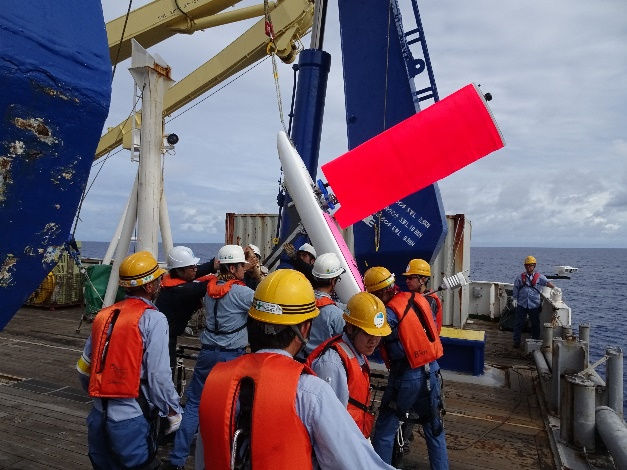Progress Report
Development of Unmanned Marine Observation Vehicles to Contribute to Forecasting and Monitoring of Typhoon Artificial Control[3] Test operation under stormy environment in the tropical northwestern Pacific Ocean
Progress until FY2024
1. Outline of the project
We conduct open ocean tests of virtual mooring drone (VMD) prototypes in the tropical Northwest Pacific Ocean, a region where many typhoons are generated and develop, during R/V Mirai cruises to validate hull control, navigation, communication, and accuracy of atmosphere-ocean sensors in stormy condition with strong wind and high waves.
In 2024, to verify weather resistance of VMD in typhoon-level stormy conditions, Mirai western North Pacific/Bering Sea cruise was selected, where extreme wind and wave conditions were more likely. International coordination for maritime research and safety measures such as deck operation procedures were prepared, ensuring a secure open ocean test under stormy conditions.

2. Outcome so far
- In 2023, VMD prototype #2 underwent its first short-term open ocean test east of the Philippines, a key typhoon generation area, during R/V Mirai tropical Northwest Pacific cruise (June–July).
- International coordination was conducted with relevant countries before submitting Marine Scientific Research (MSR) application through the Ministry of Foreign Affairs. Comprehensive safety measures were prepared, including deck operation procedures for deployment and recovery of VMD, ensuring a safe test without losing the prototype.
- To verify the weather resistance of the further improved VMD prototype #3, the final open ocean test was conducted in 2024 during R/V Mirai western North Pacific/Bering Sea cruise (MR24-07 Leg 1, October–November), where typhoon-level strong wind and wave conditions were expected. As in the previous year, thorough appropriate preparation and stringent safety measures ensured a successful test without any incidents.


3. Future plans
One of the future development challenges is ensuring long-term operation in the vicinity of typhoons. To achieve this, open ocean tests based on autonomous return (recovery) from coastal areas like Okinawa are essential. We will continue part of the development through the K Program.